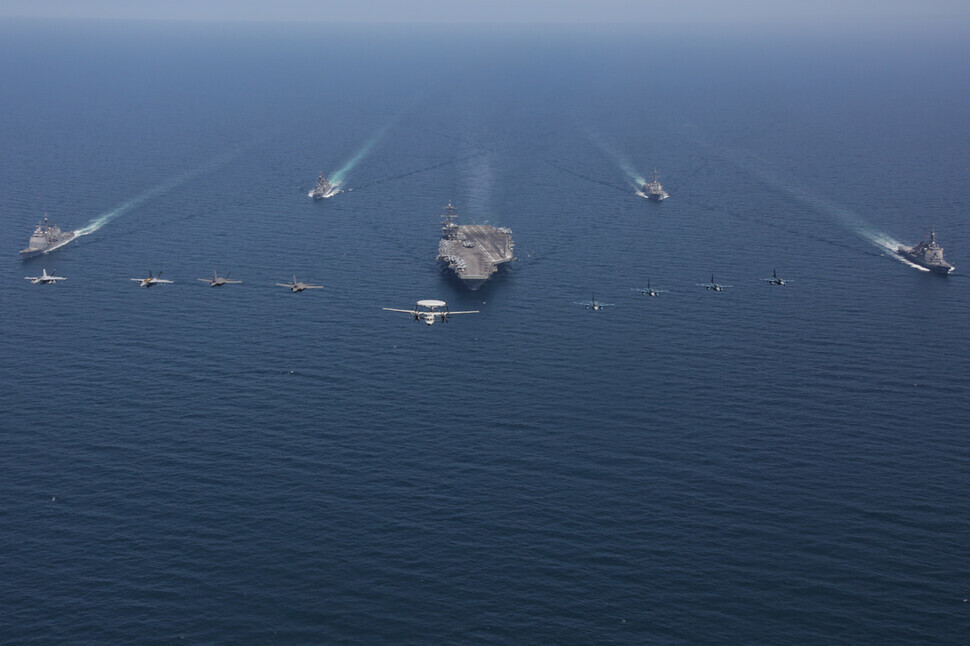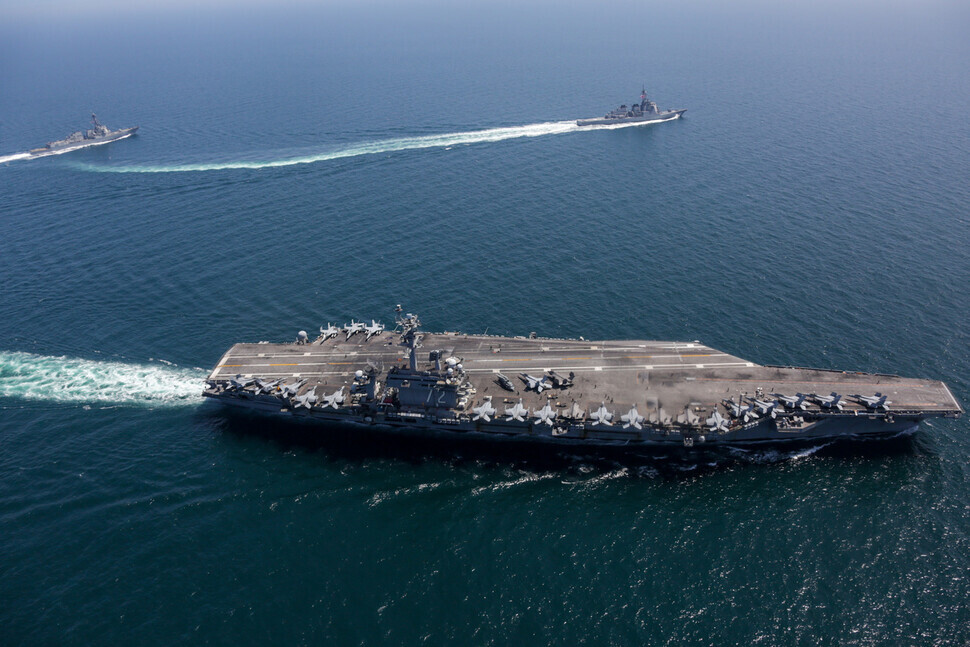hankyoreh
Links to other country sites 다른 나라 사이트 링크
US, Japan conduct joint exercises in East Sea in open show of force to N. Korea

For the first time in four years and five months, a US aircraft carrier has entered the East Sea and is conducting joint exercises with Japan's Maritime Self-Defense Forces.
The move is interpreted as an attempt by the two allies to deter North Korea from launching another intercontinental ballistic missile (ICBM) or testing a nuclear weapon in the coming days as we near the Day of the Sun on April 15, the anniversary of Kim Il-sung's birth.
However, the move could end up further jeopardizing the situation around the Korean Peninsula by provoking North Korea.
On Wednesday, the US 7th Fleet posted four photos of the joint exercises on Twitter. The caption read “USS Abraham Lincoln (CVN 72), USS Mobile Bay (CG 53), USS SPRUANCE (DDG-111), [Japan Maritime Self Defense Forces] (JMSDF) Kongō-class guided-missile destroyer JS Kongō (DDG 173), and JMSDF Murasame-class destroyer JS Inazuma (DD 105) sail in formation during a U.S.-Japan bilateral exercise.”
The 7th Fleet further added, "During bilateral exercises between Abraham Lincoln CSG and JMSDF, the two navies strengthen all-domain awareness and maneuvers across a distributed maritime environment.”
The Twitter thread further stated, “Bilateral operations like this one reassure our allies and partners of the U.S. commitment to maintaining a free and open Indo-Pacific region.”
Japan’s NHK said in a broadcast on Wednesday that a helicopter had “observed the USS Abraham Lincoln passing eastward through the Tsushima Strait around noon on April 11,” adding that “the US Navy destroyer USS Spruance and the Japanese Maritime Self-Defense Force frigate Inazuma could also be seen nearby.”
It is the first time a US Navy aircraft carrier has entered the East Sea since November 2017, when North Korea conducted its sixth nuclear test and fired an ICBM.

Prior to this exercise, the US and Japan had repeatedly proposed three-way military exercises involving South Korea during high-level consultations between the three countries in February and March, but the South Korean government reportedly did not agree to participate.
At the time, it was not confirmed exactly what these exercises would look like, but it is possible that they would be aimed at deterring further North Korean provocations ahead of the Day of the Sun.
Back in November 2017, the US also deployed three aircraft carriers, including the USS Ronald Reagan, to carry out three-way joint training in the East Sea, but the Korean government did not respond that time either.
Displeased with Seoul’s attitude, Japanese media at the time reported that “Japan considered a plan to conduct a trilateral joint exercise, but no coordination was reached with South Korea.”
However, despite the joint exercises between the US and Japan at the time, North Korea did not give in to this kind of “pressure.” Instead, they launched a Hwasong-15 ICBM — capable of reaching the US mainland — in the same month and also declared the “completion” of the country’s national nuclear force.
Nevertheless, regarding the current drills, Japan’s Chief Cabinet Secretary Hirokazu Matsuno said that the current exercises are “intended to strengthen Japan-US solidarity and are not conducted with a specific country in mind,” adding, “Going forward, we will do our best to defend our country by constantly strengthening the deterrence and response capabilities of the Japan-US alliance.”
By Kim So-youn, Tokyo correspondent; Gil Yun-hyung, staff reporter
Please direct questions or comments to [english@hani.co.kr]

Editorial・opinion
![[Column] Season 2 of special prosecutor probe may be coming to Korea soon [Column] Season 2 of special prosecutor probe may be coming to Korea soon](https://flexible.img.hani.co.kr/flexible/normal/500/300/imgdb/original/2024/0426/3317141030699447.jpg) [Column] Season 2 of special prosecutor probe may be coming to Korea soon
[Column] Season 2 of special prosecutor probe may be coming to Korea soon![[Column] Park Geun-hye déjà vu in Yoon Suk-yeol [Column] Park Geun-hye déjà vu in Yoon Suk-yeol](https://flexible.img.hani.co.kr/flexible/normal/500/300/imgdb/original/2024/0424/651713945113788.jpg) [Column] Park Geun-hye déjà vu in Yoon Suk-yeol
[Column] Park Geun-hye déjà vu in Yoon Suk-yeol- [Editorial] New weight of N. Korea’s nuclear threats makes dialogue all the more urgent
- [Guest essay] The real reason Korea’s new right wants to dub Rhee a founding father
- [Column] ‘Choson’: Is it time we start referring to N. Korea in its own terms?
- [Editorial] Japan’s rewriting of history with Korea has gone too far
- [Column] The president’s questionable capacity for dialogue
- [Column] Are chaebol firms just pizza pies for families to divvy up as they please?
- [Column] Has Korea, too, crossed the Rubicon on China?
- [Correspondent’s column] In Japan’s alliance with US, echoes of its past alliances with UK
Most viewed articles
- 1‘We must say no’: Seoul defense chief on Korean, USFK involvement in hypothetical Taiwan crisis
- 2After election rout, Yoon’s left with 3 choices for dealing with the opposition
- 3AI is catching up with humans at a ‘shocking’ rate
- 4Why Kim Jong-un is scrapping the term ‘Day of the Sun’ and toning down fanfare for predecessors
- 5[Editorial] Korea’s surprise Q1 growth requires objective assessment, not blind fanfare
- 6Noting shared ‘values,’ Korea hints at passport-free travel with Japan
- 7Two factors that’ll decide if Korea’s economy keeps on its upward trend
- 8Gangnam murderer says he killed “because women have always ignored me”
- 9The dream K-drama boyfriend stealing hearts and screens in Japan
- 10Yoon says collective action by doctors ‘shakes foundations of liberty and rule of law’